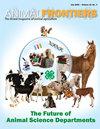畜牧生产系统和生态系统服务的价值
IF 4.2
2区 农林科学
Q1 AGRICULTURE, DAIRY & ANIMAL SCIENCE
引用次数: 0
摘要
作为人类,我们有义务确保我们实现和维护粮食安全基础设施的方法与我们使用的景观相兼容。我们每天都意识到并被提醒,不小心实施的农业做法可能永久性地损害景观和固有的生态系统服务(效益)。因此,我们必须始终努力创造这样一种农业系统,在确保足够的粮食生产以满足不断增长的人口的营养需求的需要与重视和维护土地生态属性的责任之间取得平衡。但是,在这里我们发现了一个困境。我们在多大程度上以牺牲其他生态系统服务为代价,利用景观进行粮食生产?此外,人类是否应该放弃长期被证明是可持续的农业系统,而将普及的生态系统服务归还给景观?这些只是挑战世界政治体系和领导人在未来几年如何养活不断增长的世界人口的众多相关问题中的一小部分。我邀请你在阅读本期《动物前沿》时思考这些问题,本期《动物农业的土地利用挑战》关注的是“动物农业的土地利用挑战”。我们知道,在世界各地,对营养食品的需求是不变的,我们所使用的牧场固有的生态效益是重要的。然而,关于如何回答这些问题,世界各国内部和世界各国的政治观点是有争议的和多样化的,这给本期《动物前沿》在全球范围内解决土地利用和动物农业问题带来了一些挑战。因此,在我们的方法中,我们首先对全球畜牧业的土地利用解决方案和挑战进行了广泛的介绍,然后将重点放在区域和国家问题上。我们从Duru及其同事(2015)开始,作者提出了一个分析框架,该框架考虑了牲畜系统的复杂性,并有助于识别社会动态、土地利用、环境影响和生态系统服务之间的关键关系。在该框架中,牲畜系统被定义为社会生态系统,以解释社会系统如何决定土地利用和生态系统服务。此外,该框架强调了牲畜系统生态现代化的两个主要途径:管理投入效率以减少负面环境影响或管理生物多样性以增加生态系统服务。作者将该框架总结为“…一个中间对象,支持利益相关者进行结构化设计和评估过程,以确定当前牲畜系统的主要问题和可能的可持续途径的特征”(Duru et al., 2015)。在您阅读后续文章时,我鼓励您反思本文以及Duru等人(2015)将合作利益相关者投入、生物多样性和生态系统服务作为可持续畜牧业系统组成部分的重点。Tolleson和Meiman(2015)提供了家畜农学家的土地利用与其他土地利用需求(农业和非农业)、意识形态和政府行为相冲突或竞争的各种情况的全球概述。作者证明,一些土地利用挑战是牲畜生产者的选择和生产实践的直接结果,而其他问题是由于民众和消费者对当今世界放牧牲畜生产的作用和地位的看法。作者还提出了可以通过与非农业团体或机构整合或建立伙伴关系来扩大放牧牲畜生产的地区,以将牲畜作为土地管理的工具。作为对Duru等人(2015)文章的补充,Tolleson和Meiman(2015)进一步强调了畜牧生产者参与、考虑和/或与社会互动的必要性,他们得出结论:“需要减轻负面影响,增强积极影响,本文章由计算机程序翻译,如有差异,请以英文原文为准。
The value of livestock production systems and ecosystem services
As humans, we are obligated to ensure that our methods to achieve and maintain a food-security infrastructure are compatible with the landscapes that we use. We are aware and reminded daily that carelessly implemented agricultural practices can permanently harm landscapes and the inherent ecosystem services (benefits). Therefore, we must always strive to create those agricultural systems that balance the need to ensure adequate food production to meet the nutrition demands of a growing population with the duty to value and maintain the land’s ecological attributes. But, herein we find the dilemma. To what extent do we utilize a landscape for food production at the expense of other ecosystem services? Furthermore, should humans abandon long-proven sustainable agricultural systems to return popularized ecosystem services to the landscape? These are but a few of the many related questions that challenge the world’s political systems and leaders in determining how to feed a growing world population in years to come. I invite you to reflect on these questions as you read this issue of Animal Frontiers, which focuses on “Land-Use Challenges for Animal Agriculture.” What we know to be constant across the world is the need for nutritious foods and the importance of ecological benefits inherent to the grazing lands we use. However, the political views within and across the world’s nations of how these questions should be answered are controversial and diverse, which posed some challenge in addressing land use and animal agriculture on a worldwide basis in this issue of Animal Frontiers. Therefore, in our approach, we begin with a broad introductory view of land-use solutions and challenges of animal agriculture worldwide and then focus in on regional and national issues. We start with Duru and colleagues (2015), where the authors present an analytical framework that considers livestock system complexity and facilitates identification of critical relationships between social dynamics, land use, environmental impacts, and ecosystem services. In the framework, livestock systems are conceptualized as social-ecological systems to account for how the social system determines land use and ecosystem services. Furthermore, the framework emphasizes two main pathways of ecological modernization of livestock systems: managing input efficiency to decrease negative environmental impacts or managing biodiversity to increase ecosystem services. The authors summarize the framework as “…an intermediary object to support stakeholders in structured design and assessment processes to identify main issues of current livestock systems and the characteristics of possible sustainable pathways” (Duru et al., 2015). As you read the subsequent articles, I encourage you to reflect on this paper and the emphasis that Duru et al. (2015) place on cooperative-stakeholder input, biodiversity, and ecosystem services as components of sustainable livestock systems. Tolleson and Meiman (2015) provide a global overview of various situations where land use by livestock agriculturalists is in conflict or competition with other land-use needs (agricultural and nonagricultural), ideologies, and governmental actions. The authors demonstrate that some land-use challenges are the direct result of livestock producers’ choices and production practices while other issues are due to the views of the populace and consumers about the role and place of grazing livestock production in today’s world. The authors also present areas where grazing livestock production could expand by integrating or establishing partnerships with nonagricultural groups or agencies to use livestock as tool for land management. Complementary to the article of Duru et al. (2015), Tolleson and Meiman (2015) further highlight the necessity for livestock producers to engage, consider, and/or interact with society by concluding that “The need to mitigate negative impacts, enhance positive impacts,
求助全文
通过发布文献求助,成功后即可免费获取论文全文。
去求助
来源期刊

Animal Frontiers
Veterinary-Food Animals
CiteScore
6.50
自引率
5.60%
发文量
74
期刊介绍:
Animal Frontiers is the official journal of the following globally active professional animal science societies:
ASAS, the American Society of Animal Science
CSAS, the Canadian Society of Animal Science
EAAP, the European Federation of Animal Science
AMSA, the American Meat Science Association
These organizations are dedicated to the advancement and dissemination of science-based knowledge concerning animal agriculture. Animal Frontiers provides a novel forum for innovative and timely perspectives that have relevance to understanding the complex dynamics at work through animal agriculture. Animal Frontiers publishes discussion and position papers that present several international perspectives on the status of high-impact, global issues in animal agriculture. Every issue will explore a theme of broad and current interest within animal science and animal agriculture.
 求助内容:
求助内容: 应助结果提醒方式:
应助结果提醒方式:


